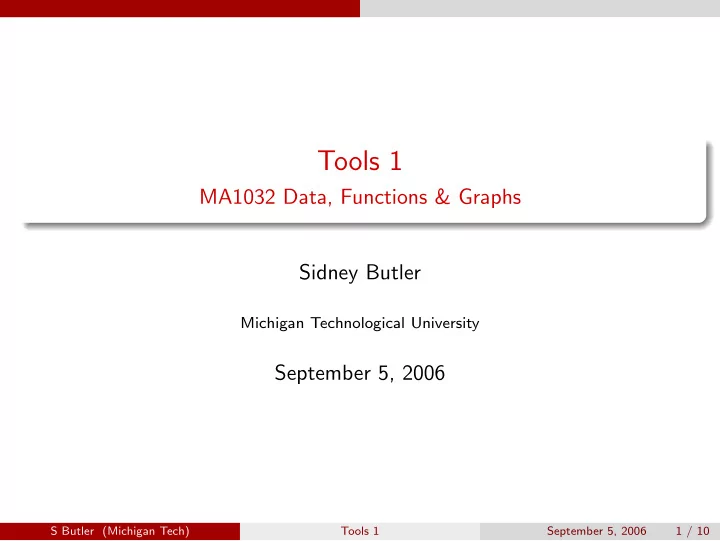

Tools 1 MA1032 Data, Functions & Graphs Sidney Butler Michigan Technological University September 5, 2006 S Butler (Michigan Tech) Tools 1 September 5, 2006 1 / 10
Definition A linear equation in two variables, say the variables x and y , is an equation that can be written in the form ax + by = c where a , b , and c are constants and a and b are not both zero. Example Determine if the following equations are linear. 1 3 x − (2 − 4 y ) = x − y + 1 x +2 − y = y 2 3 5 3 x 2 − ( x − 3) 2 = 3 y S Butler (Michigan Tech) Tools 1 September 5, 2006 2 / 10
Solving Exactly vs. Solving Approximately Example 3 π Solution: 2 or 6 . 66432440724 √ Each has its benefits. S Butler (Michigan Tech) Tools 1 September 5, 2006 3 / 10
Definition A system of equations is a group of equations. Definition The simultaneous solution to a system of equations is a solution that satisfies all of the equations in the system. S Butler (Michigan Tech) Tools 1 September 5, 2006 4 / 10
Example Show that the coordinate (4 , − 1) is the simultaneous solution to the following system of equations. � x + y = 3 x − y = 5 Example Is the coordinate (1 , 2) the simultaneous solution to the following system of equations? � 3 x − 2 y = 6 y = 2 x − 5 S Butler (Michigan Tech) Tools 1 September 5, 2006 5 / 10
Methods for solving systems of equations. 1 Substitution. Solve for one variable in an equation and then plug it into the others. 2 Elimination. Multiply one equation by a convenient constant and then add the equation to another equation. S Butler (Michigan Tech) Tools 1 September 5, 2006 6 / 10
Example Solve the following systems of equations. � 2 x = 10 y − 1 + 2 y = 15 x � x = 7 y − 9 2 4 x − 15 y = 26 � 3 x y = 17 − 3 − 2 x 3 y = − 4 − � 2 x + 3 y = 7 4 y = − 3 5 x + 6 S Butler (Michigan Tech) Tools 1 September 5, 2006 7 / 10
Application. Finding the intersection of two lines. Example Find the intersection of the lines y = x + 1 and 2 x + 3 y = 12. 8 6 4 2 -2 2 4 6 8 S Butler (Michigan Tech) Tools 1 September 5, 2006 8 / 10
Example Where do the lines y = 2 x − 3 . 5 and y = − 1 2 x + 4 intersect? 15 10 5 -2 2 4 6 8 10 -5 S Butler (Michigan Tech) Tools 1 September 5, 2006 9 / 10
Summary. 1 Linear Equations 2 Exact vs. Approximate Solutions 3 Systems of Equations 4 Substitution & Elimination S Butler (Michigan Tech) Tools 1 September 5, 2006 10 / 10
Recommend
More recommend